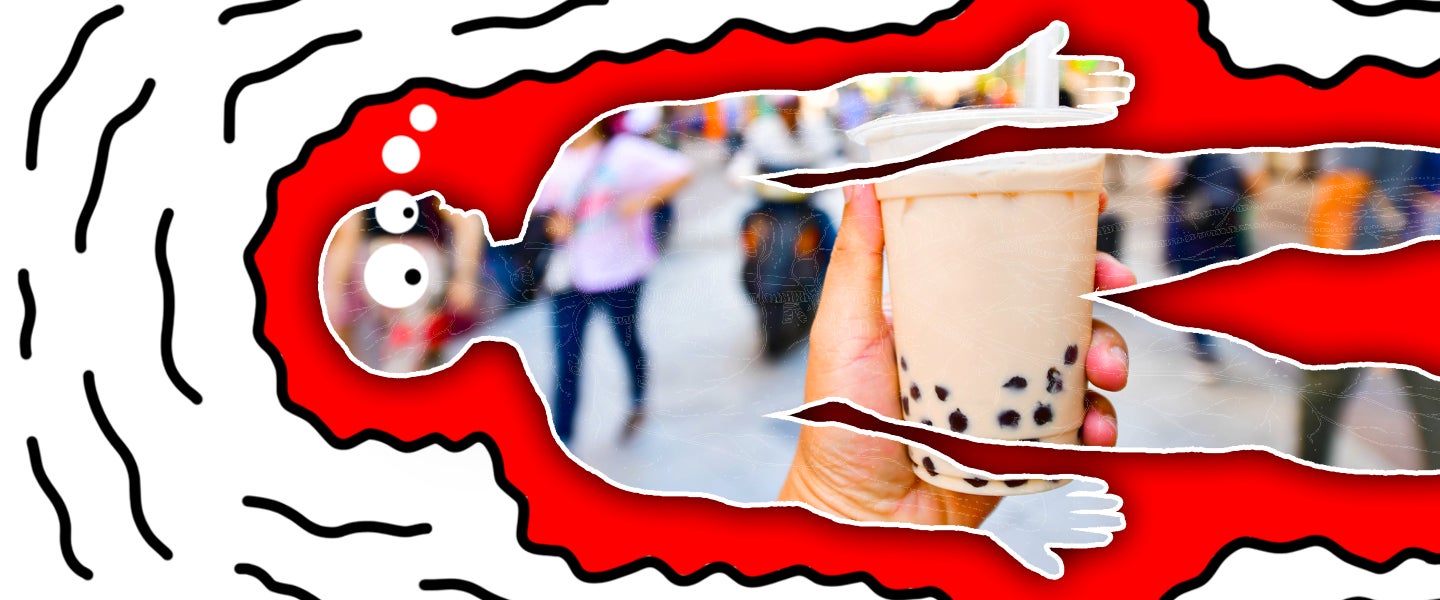The human body: An inspiring biological work of art? Or a meaty sack of germs and fluids? Either way, there’s still a lot we don’t know about what goes on in there — and scientists are constantly attempting to find out more. Here are the most interesting things we learned about our bodies in the last seven days…
Boba Wants to Live in Your Gut Forever
Obviously, the best part of boba tea is the actual boba. Slurping up those gooey balls through a straw is incomparably satisfying and I completely understand why this 14-year-old Chinese girl ended up eating so many boba that they caused an abdominal blockage.
After five days of constipation, stomach pain and lack of appetite, the girl went to the hospital, where a doctor conducted a tomography scan of her belly. The scan showed round shadows all throughout her digestive tract, all the way down to her anus. Fortunately, a laxative took care of the problem.
The girl in question alleges she only had one boba drink, but that seems… unrealistic? Either way, it’s a good lesson in chewing your food properly, especially when it comes to this stuff. Boba pearls are usually made of difficult-to-digest tapioca starch, and are often boosted with thickeners, so if you aren’t chewing them up well enough, be prepared to thoroughly balls up your guts.
Schizophrenia Is in Your Voice
Researchers have found a way to use machine-learning to analyze people’s language for early signs of psychosis. When a machine assessed diagnostic interviews with 40 people at risk for schizophrenia and compared the results to those not at risk, researchers at Emory University and Harvard University found that those at risk used more words associated with sound (including things like “whisper,” “voice” or “loud”), as well as speaking more vaguely.
In order to teach the computer what “normal” language looked like, the researchers input conversations from 30,000 users on Reddit (that seems like a mistake, but fine). The data found that “higher than normal usage of words related to sound, combined with a higher rate of using words with similar meaning, meant that psychosis was likely on the horizon.” The difference is so subtle, however, that researchers never noticed it on their own.
While this research makes me concerned for my own mental health, as I have the vocabulary of a parakeet, I don’t have too much faith in researchers who think redditors are indicative of what’s “normal.”
Sleeping With the TV On Will Make You Huskier
People often need a very specific set of conditions to be met in order to fall asleep: Some need to be completely naked with approximately one and a half pillows in a 64-degree room, while others might need a weighted blanket and the TV on mute in order to pass out. Sadly, if you’re in the latter camp, you might gain some weight, according to a recent JAMA study. Researchers found that women who slept with the TV on (or another source of bright artificial light) gained an average of 10 pounds over a five-year period. The same wasn’t true for the women who slept in the dark.
If for some reason you absolutely cannot sleep without the soothing glare of the TV, know that the health risks of sleep deprivation are far worse than gaining a few pounds over five-year stretch. So do what ya gotta do, but keep this in mind.
Having a “Type” Isn’t Bullshit After All
Saying you have a romantic “type” seems like a good way to sound narrow-minded and picky, but it turns out that there’s some validity to the claim. Social psychologists at the University of Toronto compared current and past relationships of 332 people and found that the personalities of these partners was relatively consistent. After asking the participants and their current and former partners to assess their personality traits (such as agreeableness, conscientiousness, extraversion, neuroticism and openness to experience), the researchers found that current and former partners often scored very similarly.
So maybe it’s fair to say your “type” is someone who makes plans and sticks to them, for example. The research, however, doesn’t prove that having a thing for blondes is necessarily ingrained.
Medical Marijuana Is (Maybe?) Linked to More Opioid Deaths
The argument that legal cannabis reduced opioid crisis deaths was key for public health advocates and marijuana activists in getting states to legalize. Unfortunately, that argument just isn’t true anymore: While studies between 1999 and 2010 found that the overdose rate was 25 percent lower in states with legalized medical marijuana, that statistic doesn’t stand up in today’s opioid climate.
Thirty-three states now offer medical marijuana and 10 offer recreational, but the opioid crisis has worsened dramatically since 2010, with most overdoses being caused by synthetic opioids like fentanyl, rather than heroin or prescription painkillers. Despite the positive correlation in previous years, states with medical marijuana are now experiencing 23 percent higher opioid overdose rates than other states. However, the researchers behind this recent study think the results are spurious, as the statistic only seemed to apply to medical marijuana.
So… weed is still good?
Yeah, let’s go with that. Please.

